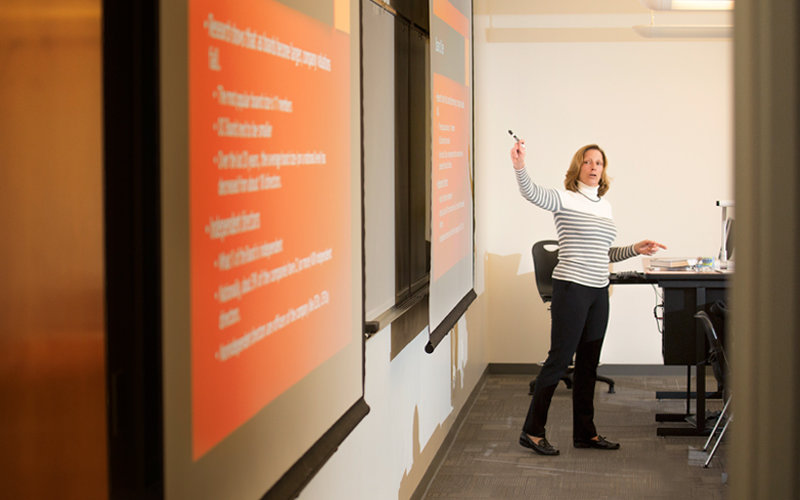
Imagine presenting a complete financial statement valuation and analysis before a panel of judges, all with years of experience in creating and reviewing such statements. That’s the challenge for students taking part in an upper-division accounting class at Cal State Fullerton’s Irvine Campus this spring.
CSUF alumna April Morris, a former CFO, vice president of finance, president and corporate CEO, has taught the course for three years and does it with the direct aim of putting students in the hot seat to watch them come into their own — with amazing results.
“A company’s valuation represents a complete window of what a company is all about,” says Morris. “Valuation includes analyzing financial statements, competition, market share, financials, earnings, debt, even how the company is expected to perform in the next five years.
“This is a difficult class,” she notes. “The lingo is different from most business classes and there are many ways of performing an analysis. But I stress that the majority of valuation relies on judgement.”
The second half of the class is where the students take what they’ve learned and apply it to practical, real-world situations. One-third of their grade comes from the financial analysis and valuation they develop, as well as how well they are able to present, communicate and respond to impromptu queries from the professionals/executives.
“The key issue is to fully understand a company’s characteristics,” explains Walter Brugman ’17 (B.A. business administration-accounting and finance). “This means understanding its goals, direction, financial statements, products, competitive positioning and even the market environment, because each and every item in the analysis was subject to change depending on the results. Understanding the ramifications of these changes was a task in itself.”
“We had to do extensive research into the company’s past, determine exactly what they do and how they operate business,” said Nathan Taylor ’16 (B.A. business administration-accounting). “There is a lot to consider when deciding how much we thought their financials would grow or decline.”
Brugman agrees. “We soon came to the realization that the amount of work that had to be done was way more than anticipated. We found ourselves collaborating as a group every week of the semester. Communicating and understanding were key in this regard.
“Around the 13th week of school, we struck an ‘aha’ moment when we finally got to see our work put together and the finishing touches completed,” says Brugman. “Looking at the model and reflecting on how each and every component worked together gave a sense of pride and joy.”
Then came the presentations.
“It was an amazing experience,” Brugman says, as well as rewarding when the judges congratulated his team on their effort, and even showed interest in interviewing team members for potential positions. “Our huge wave of relief came with an acknowledgement of a job well done.”
“All my students tell me it’s the hardest class they have ever taken, but that it is also the most rewarding,” Morris says. “My job is to make sure they have the skills that it takes to have a successful career.”
“Since I had no work experience when I graduated, this class gave me the ‘experience’ I needed for any entry-level job,” agrees Taylor. “Working with teams, preparing the presentation and giving the presentation has given me certain skills that others might not have.”
“This class was the single most important class I have taken,” adds Brugman. “I would gladly recommend this class again and again because of all the skills I’ve learned from Professor Morris.”